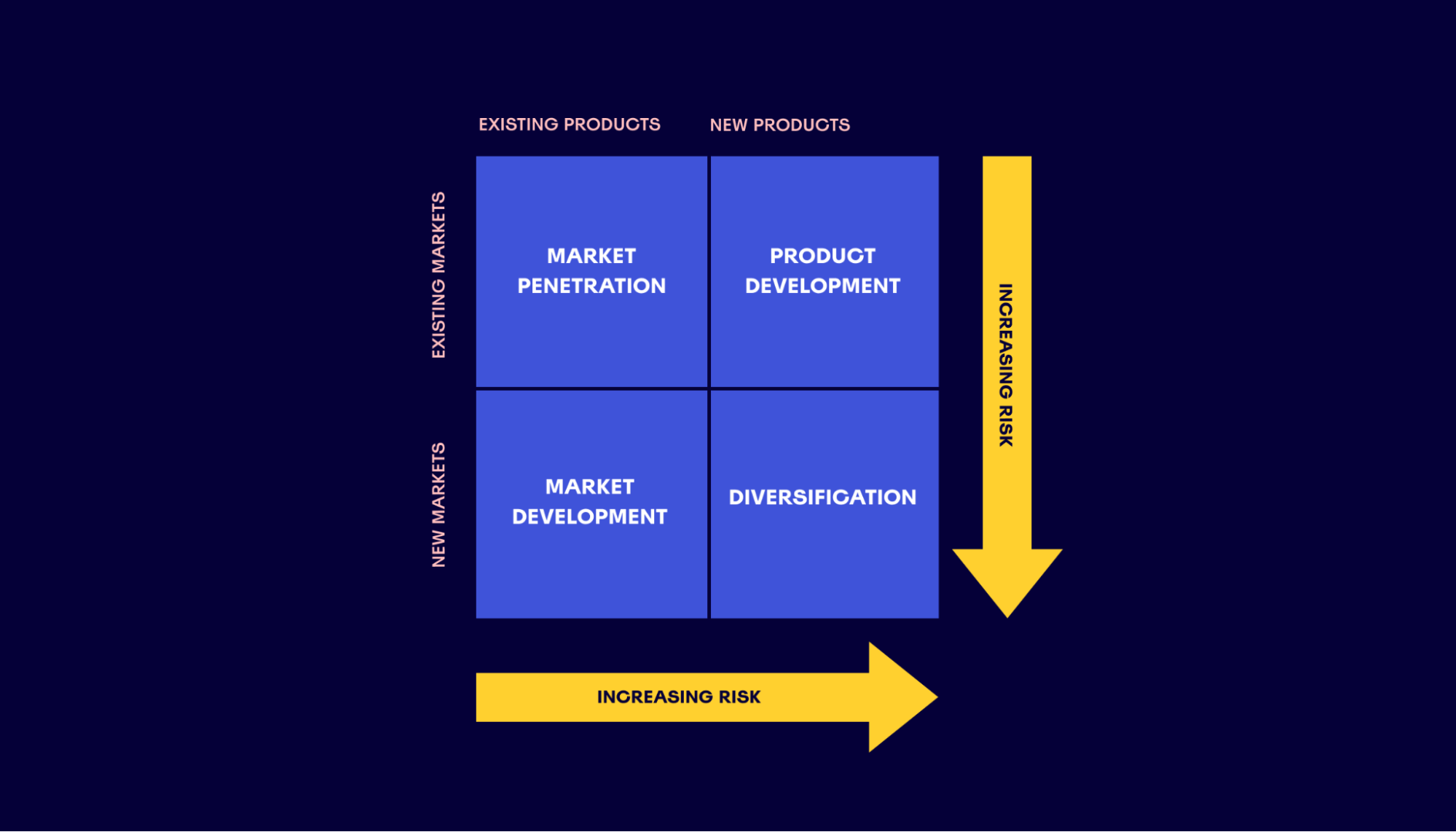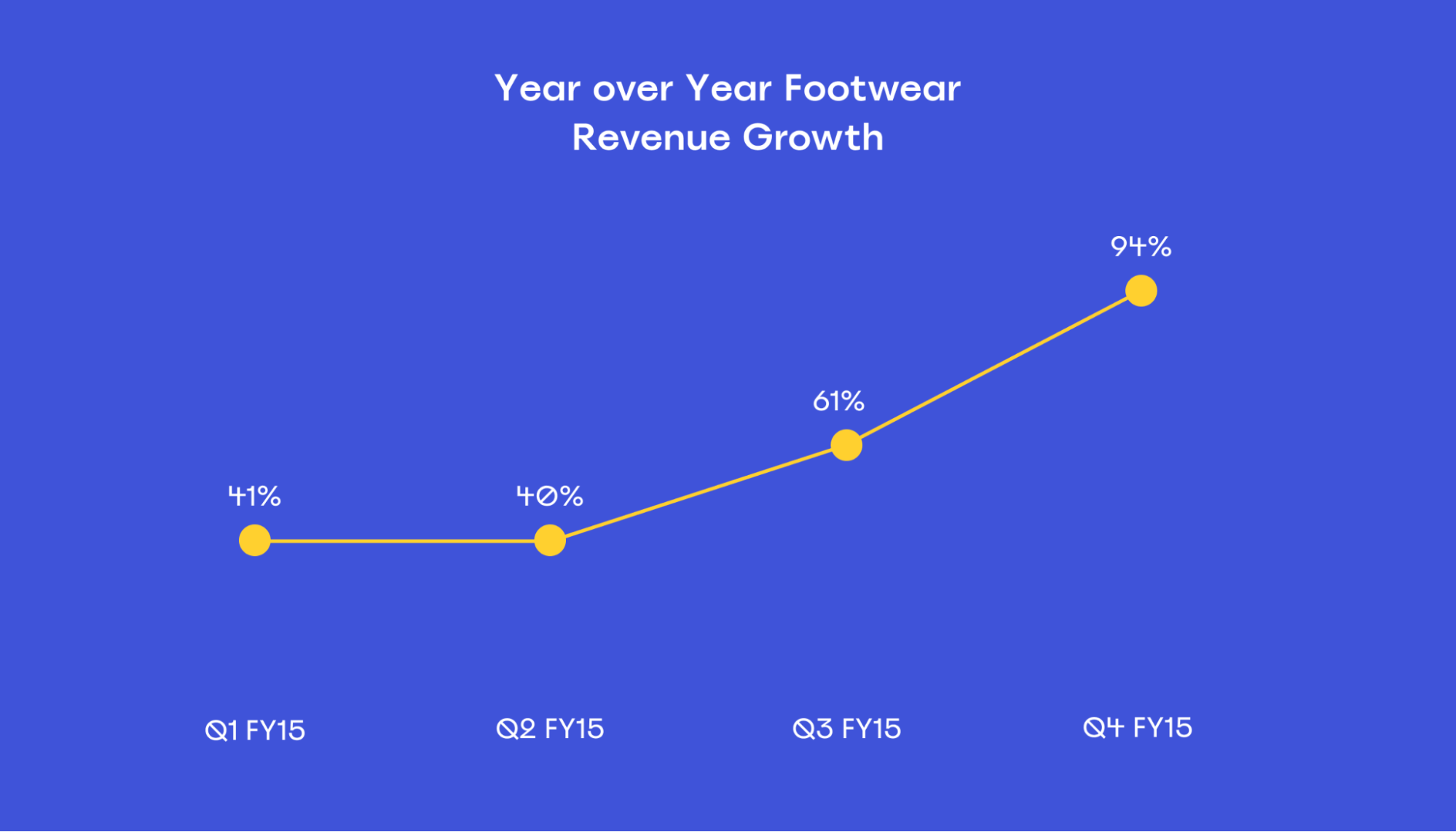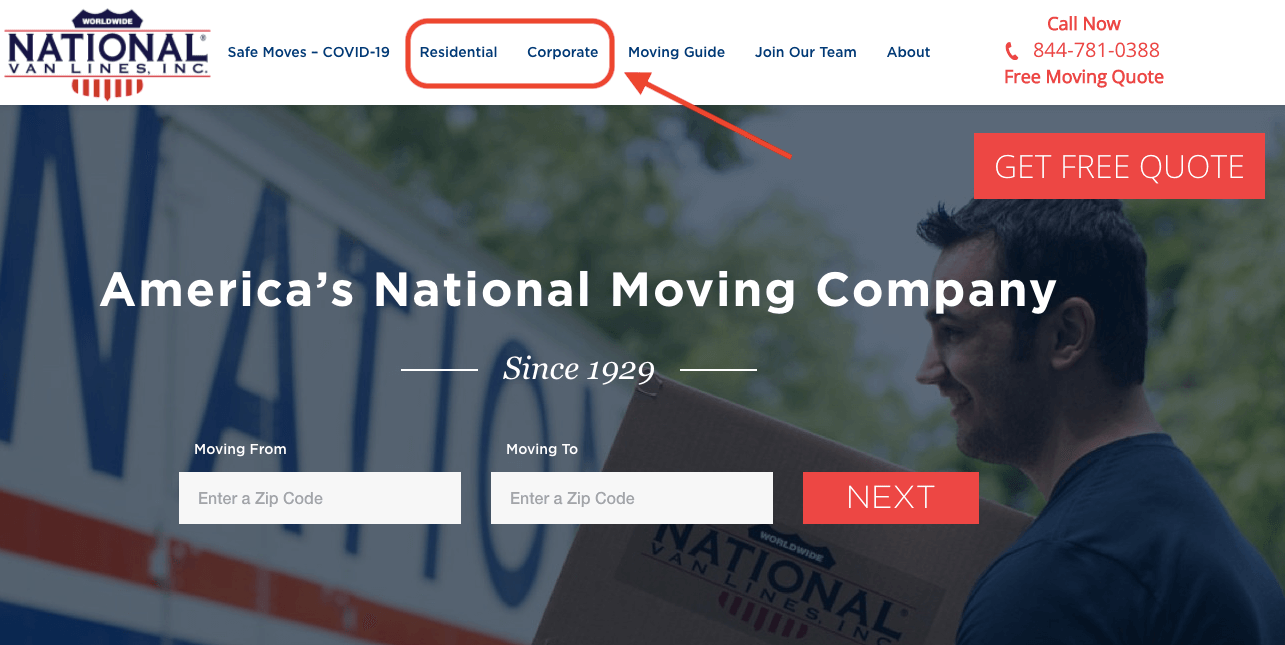If the last couple of years have taught us anything, it’s that the marketplace can change quickly and without warning. In case you were wondering, yes — we are talking about the pandemic.
To keep up with changes, businesses need to adapt to their surroundings. This means creating new plans for growth and tailoring your business strategy to align with market trends and consumer behavior.
But how can you create a corporate strategy that’ll help your business succeed in the long run?
Enter the Ansoff Matrix.
The Ansoff Matrix helps businesses figure out which avenue to go down to give themselves the best chance of growth and success.
Keep reading to find out more about what the Ansoff Matrix is, how to implement it in your business, and the pros and cons of using it.
What is the Ansoff Matrix?
The Ansoff Matrix is a strategic tool that helps businesses evaluate growth opportunities. Also known as a product or market expansion grid, it can come in various formats. But generally speaking, people use Igor Ansoff’s matrix from 1957 (see below).
The matrix has four key quadrants: market penetration, market development, product development, and diversification (more on this later). Using the grid, businesses review the potential risks of each option and create a growth plan.

What are the benefits of using the Ansoff Matrix?
Now that we know what the Ansoff model is, let’s take a look at some of the benefits of using it.
Assess risk
Analyzing risk is a key part of business growth. If you’re not prepared for what might go wrong, you’re putting your business in a pretty vulnerable position.
That’s where an Ansoff Matrix strategy can help. Each quadrant helps business owners weigh the risks and prepare accordingly.
Imagine you’re thinking about diversifying your product market. You currently sell your product in the U.S., and you want to expand to the UK market.
The Ansoff Matrix helps you identify the risks associated with this diversification strategy. For instance, you might have to offer your product at a lower price to penetrate the market. This could mean losing out on potential revenue for the first six months of the expansion.
By identifying this potential risk, you can prepare your business to deal with it and give your growth strategy the best chance of success.
Identify the best strategy for growth
If you’ve decided to use the Ansoff Matrix, chances are you want to experience business growth.
The good news is, you’ve picked the right tool.
The Ansoff Matrix is designed to help businesses take a strategic approach when planning business growth. Using the four quadrants (which can be filled in using the Ansoff Matrix template below), businesses make informed decisions about which avenue to pursue with the highest chance of success.

It also helps you identify new strategies for growth that you might never have thought about before. If you’re thinking about how you can grow and develop your business, the Ansoff Matrix is a great place to start.
Are there any downsides to the Ansoff Matrix?
As with every business tool, there are pros and cons. The Ansoff Matrix is no exception, so let’s take a look at some of the downsides.
The reward isn’t measured
To make a well-rounded decision, it’s helpful to compare risk with reward. Unfortunately, the Ansoff Matrix doesn’t allow you to do this. And without this additional information, you could miss out on potential growth opportunities.
Let’s say you’re using the Ansoff Matrix. You look at how you can boost sales with your current product in your current market (market penetration). You also look at launching a new product to a new market (diversification). The matrix tells you that trying to boost sales in your current market is low risk, while launching a new product is high risk.
This is correct, but the matrix hasn’t taken reward into account. Launching a new product to a new audience could have a greater return on investment (ROI) in comparison to boosting sales on existing products. The risk might be higher, but the reward might be as well.
It’s tricky to compare risk and reward with the Ansoff Matrix. You’ll have to do this separately to figure out if your strategy is an avenue worth pursuing.
It doesn’t capture the big picture
The matrix is great for helping you plan your strategy, but it’s pretty simple in its structure. As a result, a lot of extra thought is required to visualize the bigger picture.
Take competitors, for example.
There’s no way to review competitors with the Ansoff Matrix. Instead, you have to do a competitor or SWOT analysis separately and integrate what you’ve learned. It’s not the end of the world, but it means that the process isn’t as streamlined and efficient as it could be.

The Ansoff Matrix is great for finding the best strategy for growth and analyzing risk, but it does have some limitations. So long as you’re aware of what these are before you start using the matrix, you can make sure your growth strategy is as robust as possible.
How to use the Ansoff Matrix for strategic planning
Ideally, you should use the Ansoff Matrix whenever you do strategic planning.
Why?
Because a successful strategy should help your business grow and succeed, and that’s exactly what the matrix does best. Some businesses also find it helpful to fill out the matrix more regularly, especially if conditions change rapidly in their industry.
So how do you use the Ansoff Matrix for strategic planning?
Unfortunately, there’s no one-size-fits-all solution. It all depends on the industry you’re in, your position in the marketplace, and what you’re trying to achieve.
However, we can offer some advice. To do this, we’re going to give you a full rundown of each quadrant, when it’s best to use it, and examples of companies that have done it well.
Understanding the four key quadrants and how they help with strategic planning
We’ve briefly touched upon the four quadrants of the Ansoff Matrix. Now, let’s look at them in more detail and outline how they can help your business with strategic planning.
Market penetration
First up, our top left contender: market penetration.
A market penetration strategy focuses on boosting sales in your existing market and to an existing customer base. For example, you could offer an incentive to increase sales. Or streamline your order and delivery process by adding more distribution channels.
It’s the most low-risk quadrant of the matrix, which makes it the “safest” option for businesses — but that doesn’t necessarily mean it’s the right choice. As we’ve already mentioned, it all depends on your goals and the industry you’re working in.
When to use market penetration
If any of these goals are on your list, market penetration could be the way to go:
- Market share growth
- Increase customer loyalty
- Improve customer value
If you decide to use market penetration, Miro’s chart feature could be incredibly useful to you. You can integrate our chart within the quadrant itself, allowing you to visualize areas where market penetration could increase your sales and improve your business.

Real-life example: Under Armour
In recent years, Under Armour has surpassed Adidas to become the second-largest athletic-wear provider in the U.S.
How?
With market penetration.
To increase its market share, the company increased spending on endorsements and advertisements by 35%. This included signing professional basketball player, Stephen Curry, to launch the Curry Brand.
This is where it gets interesting.
The release of his signature shoe resulted in footwear growth of almost 95%.

This is a great example of using market penetration to increase market share. By releasing a new product with a well-established sportsperson, Under Armour surpassed Adidas to become the second-largest athletic-wear provider in the U.S.
Product development
Product development involves introducing a new product into the marketplace. Or, if you’re a SaaS business, introducing a new service.
When to use product development
The clue is in the name with this one. Generally speaking, most businesses use a product development strategy for the following:
- To expand their current product line/services
- To offer a completely new (but similar) product to the same market
If you’re thinking about pursuing product development, take a look at Miro’s collaboration tools.
A product development strategy will require a team of people to pull it off, so using a collaborative platform is pretty important. This is where Miro can help.
With our software, teams can seamlessly collaborate and communicate across departments. For example, users can add comments, tag users, and even share their screens.

Real-life example: Karma
Karma’s co-founders, Stas Kulesh and David Kravitz, had been running their own design and development company for over 10 years.
When the team shifted from using email communication to business chats, they created Karma. It started as a rustic, internal tool to keep each other accountable and motivated.
Using Miro to collaborate and communicate, the team began to share, discuss, and document their ideas about how Karma could be used by other businesses. The visual workspace became a vital and multipurpose tool for Karma’s distributed team during various stages of development.
The company used brainstorming and impact mapping templates to create a visual overview, allowing everyone involved to see the current status of the project.

Before long, the Karma Bot was born. Karma Bot is a tool used by teams to track performance, handle promotions, assign rewards and bonuses, and review salary appraisals.
After launching the product, it was quickly apparent that other companies were interested in using the services Karma Bot had to offer. By using product development, Karma fulfilled a need in the marketplace and provided consumers with a new, in-demand service.
Market development
Market development is riskier than both market penetration and product development. It involves launching an existing product into a new market. This can be done as follows:
- Finding a new use case for your product
- Adding features to meet a different customer need
When to use market development
Market development is often used when a business wants to diversify its audience. For instance, if it’s targeting an audience aged 18-25, the business might try to target an audience aged 19-30.
It can also be used if a business discovers a new use for its product or service. For instance, some changes in the marketplace could mean that you have a whole new audience to target.
Look at the pandemic, for example. Before, face masks would usually have only been supplied to medical offices and hospitals. Now, they’re supplied to businesses of all sizes and varieties as well as individual consumers.
If you’re considering market development, take a look at our user persona template to help you figure out who your new target audience will be.

Real-life example: National Van Lines
National Van Lines started as a B2C company, helping customers with their moving needs. However, the company used a market development strategy to expand into the B2B market.
By partnering with regional companies and agents, National Van Lines expanded its sales reach to include national and international B2B relationships.

By working with these partners, the company built direct relationships and expanded its B2B sales. They still offered the same service to their existing customers but also targeted a whole new customer base with the same service.
Diversification
Diversification is the riskiest of all the quadrants. It involves introducing an entirely new product into a new market.
Successful diversification takes a lot of work. You need to be extremely clear on your business goals, prepare yourself for the risks, and thoroughly review your financial situation. You’ll also need a solid marketing team in place to make sure there’s a market for your new product or service and that you launch everything successfully.
Although it’s the riskiest, it can have the biggest payoff — when used in the right circumstances, of course.
When to use diversification
Here’s when you might consider using diversification:
- If you want to expand into a new industry or market you haven’t currently explored.
- If you’re looking to expand your current business. For example, a graphic design company that starts to offer design products. This might still appeal to their current audience, but they’ll also reach a whole new audience in the process.
If you opt for diversification, check out Miro’s product development roadmap template. This template will help you plan, manage, and execute the roadmap for your new product.
Real-life example: HubSpot
Hubspot began in 2006 as a content and customer management platform for small businesses with one to 10 employees. By 2008, they had 600 customers.
As time went on, they adapted to the marketplace and created new features. This allowed them to diversify, creating an entirely new product for a new audience — a CRM for enterprise-level businesses.

Today, they are an all-in-one CRM platform with 121,000 global customers. It’s safe to say their diversification efforts paid off.
Start using the Ansoff Matrix today with Miro
By now, you should have a pretty solid understanding of how to use the Ansoff Matrix for strategic planning. You know what each quadrant means and how to use them, and you’ve got some real-life examples to inspire you.
If you want to get started, take a look at our Ansoff Matrix template. With functionalities like sticky notes, pen tools, and shapes, you can use it to map out your strategic ideas in a visual, easy-to-understand way.
Miro is also a great tool for cross-functional collaboration, allowing teams to communicate and work together from one central platform. If you’ve got a remote team, using our platform is a pretty handy way to keep collaboration smooth and efficient.






